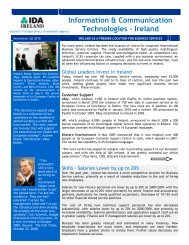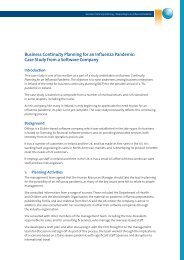Creativity - IDA Ireland
Creativity - IDA Ireland
Creativity - IDA Ireland
You also want an ePaper? Increase the reach of your titles
YUMPU automatically turns print PDFs into web optimized ePapers that Google loves.
MANAGEMENT INNOVATION »<br />
“That taboo has a lot to do with it,<br />
because if it’s taboo we don’t want to<br />
discuss it, we do it behind closed<br />
doors. And typically what we do behind<br />
closed doors and in the dark is<br />
not going to be dealt with very seriously,<br />
very systematically. It’s not<br />
going to produce very good results.<br />
So we are doing imitation, but we’re<br />
not doing it right.”<br />
“There is only one area that has fallen behind and remains<br />
with the old perspective and that is, I regret to say, business administration.<br />
Which is kind of funny because you expect business<br />
to be ahead of the game! But we are not, and I think there<br />
are very, very important lessons to be learned from that,” says<br />
Shenkar.<br />
Whether those in business will be open to embracing the idea<br />
remains to be seen, he maintains. This taboo we have already<br />
discussed is part of the problem, as it means imitation in strategy<br />
is somewhat ignored when it comes to business strategy.<br />
“Reading some of the early texts, there were very few people<br />
that noticed the importance of imitation,” Shenkar explains.<br />
“Theodore Levitt, for instance, who wrote for the Harvard Business<br />
Review back in the 1960s, he looked at companies and he<br />
found out that the same company that had invested a lot of time<br />
and developed a system to handle innovation dealt with imitation<br />
in a most amateurish fashion. That’s 50 years ago. I was<br />
shocked to find that that remains the case today.<br />
ACCELERATING RATE<br />
In Copycats, Shenkar argues that the<br />
rate of imitation is in fact accelerating.<br />
“Many will counter argue that in<br />
a modern environment, innovation is<br />
ever more important, because the<br />
pace of, for example, product introduction<br />
is so much faster. My answer<br />
to that is that this is precisely what<br />
makes imitation also much more important.<br />
“You need only look to historical<br />
data. If you look at something like<br />
porcelain which was invented in<br />
China around the 7th or 8th century<br />
during the Tang Dynasty, it took European<br />
nations about 1,000 years to<br />
replicate it – and not for lack of trying!<br />
“Then the further up you go, you<br />
see that the length of time shortens<br />
dramatically, so if you think of the<br />
phonograph that Thomas Edison invented,<br />
it took about 30 years before<br />
we had the first commercial version.<br />
The compact disc – it took three<br />
years.”<br />
Shenkar looks also at prescription<br />
drugs. “It really began in the 1960s<br />
and then it took maybe two years before<br />
somebody would come up with a generic substitute. Then<br />
it went down to nine months. Then for Prozac, it took two<br />
months. And you see it in almost everything else, whether it’s a<br />
product like a savings plan for a bank or a business model or a<br />
service.”<br />
“And it is because of this acceleration that you’ve got to have<br />
the capability, you’ve got to have the infrastructure to actually<br />
process it, turn it into a successful imitation. But until we put<br />
our mind to it and do it in the right fashion, and systematically,<br />
our chances of doing it right are really slim.<br />
“Then we fail and it’s easy to come and say: ‘Imitation doesn’t<br />
work, imitation doesn’t pay’. Well, it’s like everything else, if you<br />
do it right it works.”<br />
Copycats: How Smart Companies Use Imitation to Gain a<br />
Strategic Edge, by Professor Oded Shenkar is published by Harvard<br />
Business Press. This article first appeared in Irish Director<br />
magazine, Spring 2011<br />
Issue 2 Spring/Summer 2011 INNOVATION IRELAND REVIEW 59

















